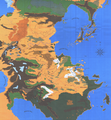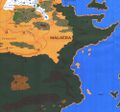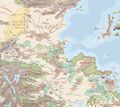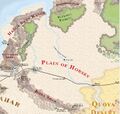Kara-Tur: Difference between revisions
No edit summary |
No edit summary |
||
| Line 14: | Line 14: | ||
* Kozakura is Sengoku-era Japan--also Kamakura era due to inclusion of retired Emperors ruling behind the scenes and series of regents being the power behind both the Shogun and the Emperor--where the feudal Daimyos fought against each other yet strangely had to no historical connections with Wa despite using Japanese aesthetics and terminology. | * Kozakura is Sengoku-era Japan--also Kamakura era due to inclusion of retired Emperors ruling behind the scenes and series of regents being the power behind both the Shogun and the Emperor--where the feudal Daimyos fought against each other yet strangely had to no historical connections with Wa despite using Japanese aesthetics and terminology. | ||
Later on, when Kara-Tur was added to Forgotten Realms--which [[Ed Greenwood]] disliked the addition due to its near-historical analogues being out of place and arguments over whether historical aspects made sense within Toril--where they added Tabot (Tibet), Bawa (Indonesia), and Malatra...which is copy-paste version of their real-world Korea while Koryo is taken straight from Korea's Three Kingdoms and the later Korea unification under Silla. | Later on, when Kara-Tur was added to Forgotten Realms--which [[Ed Greenwood]] disliked the addition due to its near-historical analogues being out of place and arguments over whether historical aspects made sense within Toril--where they added Tabot (Tibet), Bawa (Indonesia), and Malatra...which is copy-paste version of their real-world Korea while Koryo is taken straight from Korea's Three Kingdoms and the later Korea unification under Silla. | ||
==Issues== | |||
There are many of the major issues, save for SJWs' accusation of orientalism and cultural appropriation (whether its legitimate or not, especially with Asian-themed pop-culture of the time and original RPG philosophies that inspire such setting) as of recently, which included these aspects: Japanese-centric narrative, low-magic, and becoming dated. First, the Oriental Adventure was published with Samurai genre in mind, many of the monsters and terms are based on Japanese or things that were called in such language. As a result, this became jarring when the game is set in Fantasy China and Korea where the NPC's were given Japanese class names (such as Samurai, Bushi, or Shugenja). Kara-Tur: Eastern Realms and Challenge of the Ronins did try to alleviate it with equivalent terminology, but the issue also plagued into the fantasy culture (many of them having their own ninjas and samurais, even those without such cultural narratives, such as Shou Lung's sectarian conflict mirroring more on Heian Japan's Buddhist Sects). Second issue is low-magic, which was the result of attempting to make Kara-Tur "authentic" even if ignoring the fantasy genre of the setting. This came to play when it was integrated into Forgotten Realms as many of the aspects becoming odd, which a place with magic pool that allow humans to live up to a century or Forbidden City's only magical defense being anti-levitation forcefield would be "mundane" to a setting that had individuals living up to millenia and proliferation of intricate magical defenses respectively. Finally, Kara-Tur becoming outdated as the current audience who would be more exposed to Avatar, Anime, and other Asian-fantasy. At the time of Kara-Tur's writings (80's and 90's), the materials on Asia for western audience and writers are minimal with available materials either being based on outdated academic thinking or unaware of such ideas. While it was "best-selling" at the time, the materials' writing would be seen as bland, especially Kara-Tur's realm books' issue with contradictory lores, inability to account for Forgotten Realm's magical aspects, and lack of editorial insights that left entries on countries with inconsistent writing styles. | |||
==Gallery== | ==Gallery== | ||
<Gallery> | <Gallery> | ||
Revision as of 17:22, 25 July 2021
Kara-Tur is a far-eastern campaign setting for Dungeons and Dragons, created by David Cook in the first edition splatbook Oriental Adventures. It was almost immediately retconned into the Forgotten Realms setting, as is the fate of all things. The setting was never really updated for 4e, although it did get an entire issue of Dragon Magazine dedicated to the area, and as of yet nothing has been forthcoming for Dungeons & Dragons 5th Edition besides a brief mention that it might be where a PC from far away originally hails from.
The setting comprises a healthy collection of far-east historical periods, including warring states period Japan (Kozakura), Imperial China (Shou-Lung, complete with Great Wall and Triads), and the lazily named Tabot (a holy-child-monk-emperor worshipping mountain theocracy). It even has a shitty-wall hating, loose collective of steppe horsemen (although not as yet a grand uniter of clans), who even got their own spin-off sub-setting called The Horde.
Dwarves in the setting are beardless, and therefore are not real dwarves.
Settings
Kara-Tur is built with China and Japan in mind, but each nation divided into two to create an adventure environment based on specific time period and theme.
- Shou Lung is an empire representing the stable periods of China with a bureaucracy and Emperor...also showing them as "good China" as almost all bureaucrats and the Emperor are non-evil alignment.
- Tu Lung is another fantasy China who broke off from Shou Lung and show off more chaotic periods of real-world Imperial China...except the aristocrats and Imperial Family being downright evil and the entire kingdom being chronically rebellious and war-torn that the one wonder why Shou Lung or other neighboring kingdoms hadn't taken over.
- Wa is the Tokugawa Shogunate, complete with a military dictatorship ruling in lieu of Emperor and the chronic issue of unemployed Samurai after unifying the warring clans.
- Kozakura is Sengoku-era Japan--also Kamakura era due to inclusion of retired Emperors ruling behind the scenes and series of regents being the power behind both the Shogun and the Emperor--where the feudal Daimyos fought against each other yet strangely had to no historical connections with Wa despite using Japanese aesthetics and terminology.
Later on, when Kara-Tur was added to Forgotten Realms--which Ed Greenwood disliked the addition due to its near-historical analogues being out of place and arguments over whether historical aspects made sense within Toril--where they added Tabot (Tibet), Bawa (Indonesia), and Malatra...which is copy-paste version of their real-world Korea while Koryo is taken straight from Korea's Three Kingdoms and the later Korea unification under Silla.
Issues
There are many of the major issues, save for SJWs' accusation of orientalism and cultural appropriation (whether its legitimate or not, especially with Asian-themed pop-culture of the time and original RPG philosophies that inspire such setting) as of recently, which included these aspects: Japanese-centric narrative, low-magic, and becoming dated. First, the Oriental Adventure was published with Samurai genre in mind, many of the monsters and terms are based on Japanese or things that were called in such language. As a result, this became jarring when the game is set in Fantasy China and Korea where the NPC's were given Japanese class names (such as Samurai, Bushi, or Shugenja). Kara-Tur: Eastern Realms and Challenge of the Ronins did try to alleviate it with equivalent terminology, but the issue also plagued into the fantasy culture (many of them having their own ninjas and samurais, even those without such cultural narratives, such as Shou Lung's sectarian conflict mirroring more on Heian Japan's Buddhist Sects). Second issue is low-magic, which was the result of attempting to make Kara-Tur "authentic" even if ignoring the fantasy genre of the setting. This came to play when it was integrated into Forgotten Realms as many of the aspects becoming odd, which a place with magic pool that allow humans to live up to a century or Forbidden City's only magical defense being anti-levitation forcefield would be "mundane" to a setting that had individuals living up to millenia and proliferation of intricate magical defenses respectively. Finally, Kara-Tur becoming outdated as the current audience who would be more exposed to Avatar, Anime, and other Asian-fantasy. At the time of Kara-Tur's writings (80's and 90's), the materials on Asia for western audience and writers are minimal with available materials either being based on outdated academic thinking or unaware of such ideas. While it was "best-selling" at the time, the materials' writing would be seen as bland, especially Kara-Tur's realm books' issue with contradictory lores, inability to account for Forgotten Realm's magical aspects, and lack of editorial insights that left entries on countries with inconsistent writing styles.
Gallery
-
Kara-Tur
-
a greater map of Toril to better see were Kara-Tur resides.
-
Malatra
-
Shou Lung
-
Tu lung
-
Wa and Kozakura
-
Koryo
-
Northern Wastes
-
Tabot
-
Plain of Horses
| Dungeons & Dragons Campaign Settings | |
|---|---|
| Basic D&D | Mystara (Blackmoor) • Pelinore • Red Sonja |
| AD&D | Birthright • Council of Wyrms • Dark Sun • Diablo • Dragonlance • Forgotten Realms (Al-Qadim • The Horde • Icewind Dale • Kara-Tur • Malatra • Maztica) • Greyhawk • Jakandor • Mystara (Hollow World • Red Steel • Savage Coast) • Planescape • Ravenloft (Masque of the Red Death) • Spelljammer |
| 3rd/3.5 Edition | Blackmoor • Diablo • Dragonlance • Dragon Fist • Eberron • Forgotten Realms • Ghostwalk • Greyhawk (Sundered Empire) • Ravenloft (Masque of the Red Death) • Rokugan |
| 4th Edition | Blackmoor • Dark Sun • Eberron • Forgotten Realms • Nentir Vale |
| 5th Edition | Dragonlance • Eberron • Exandria • Forgotten Realms • Greyhawk • Ravenloft • Ravnica • Theros • Spelljammer • Strixhaven • Radiant Citadel |














